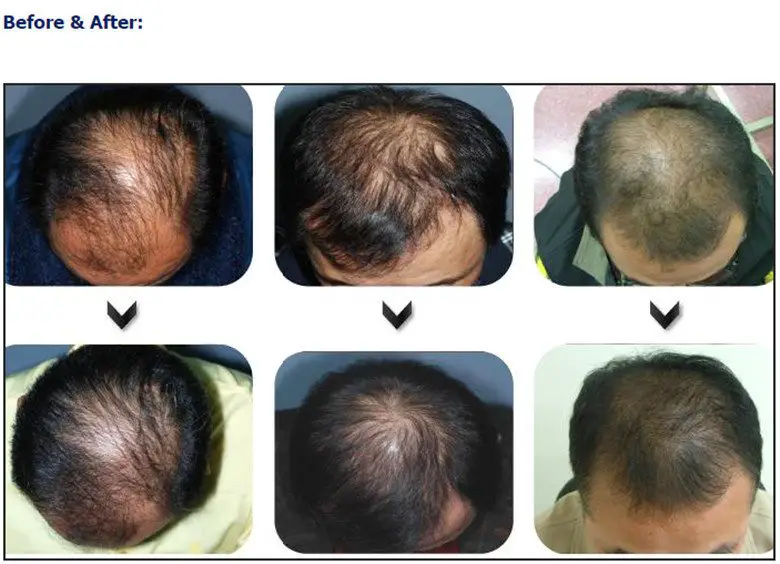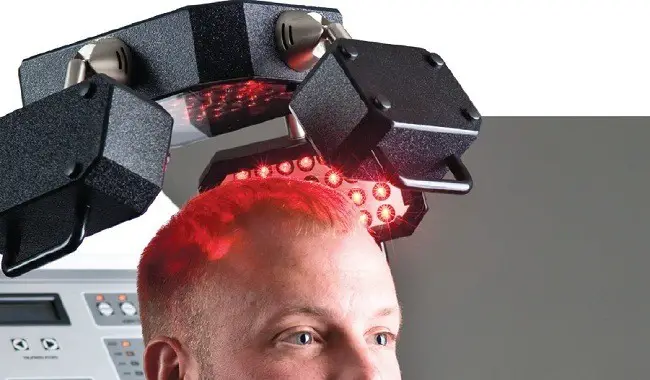Most of us tend to take our hair for granted, especially at an early age. Yet, if you suffer from hereditary hair loss, you know it has the potential to be a frustrating condition that can lead to worsening mental health, social isolation, and even physical discomfort.
Every year, thousands of sufferers across the globe seek out the latest treatments, gadgets, and pills in an attempt to tackle pattern hair loss, spot baldness, and other forms of alopecia…with mixed success.
Enter infrared light – a risk-free treatment that’s safe, non-invasive, gentle, natural, and (most importantly) effective. Red light therapy is becoming increasingly popular as an alopecia remedy as it doesn’t just reduce hair loss but also encourages the formation of new hair follicles.
FDA approved and with no side effects, infrared therapy provides a painless option for people who are losing their locks but reluctant to try medications or hair transplant surgery.
How does red light therapy help hair regrowth?
Interested in learning how infrared laser therapy can treat genetic hair loss?
Studies show hair regrowth occurs when the scalp is exposed to wavelengths of 655nm. Low-frequency red light uses wavelengths between 630 and 670nm to penetrate the hair follicles, paving the way for healthy regrowth.
This type of infrared laser hair therapy can be performed in specialized clinics and salons (by trained professionals) or even done from the comfort of your own home using FDA-approved Low-Level Laser Therapy (LLLT) devices.
How infrared light works with your hair’s natural growth cycles
The average adult has around 5 million hair follicles, and their hair grows at a rate of 0.2 – 0.7 inches every month. Those millions of follicles are constantly busy, moving through the various stages of their growth cycles.
There are four main phases of hair growth:
- The Anagen Phase – this is also known as the growth stage, or when the hair begins to lengthen. Many things can affect this phase, including seasonal changes (hair tends to grow faster in the heat), malnutrition, and genetics.
- The Catagen Phase – this transition stage is when follicles begin to shrink, and hair prepares to move from the growing phase into the resting phase.
- The Telogen Phase – this is when your hair follicles become dormant. At this stage, they’re just waiting and replenishing to get ready for the next round of growth.
- The Exogen Phase – into the final stretch, your hair now begins to weaken and shed. This is when you’ll see a few more hairs in your hairbrush as old-growth clears to make way for new. Normally, each follicle operates according to its own cycle to prevent all the hair from falling out at once.
Stimulating hair follicles with red light therapy helps shift them into their primary growing stage (the anagen phase) and restore hair growth. In this way, LLLT prolongs the growth cycle and increases proliferation and growth in the crucial anagen phase.
Exposing the molecules in hair follicles to lower wavelengths (630-670nm) stimulates their epidermal stem cells, which play a pivotal role in the follicle’s regeneration. LLLT also decreases inflammation and increases local blood flow (microcirculation), which, in turn, increases nutrient and oxygen delivery to the hair.
With this type of targeted treatment, hair loss is greatly reduced, and many patients find themselves with thicker, fuller hair after just a few sessions. In one landmark study, women with alopecia noted a 37 percent increase in hair growth after weekly treatments.
What type of Hair Loss does Red Light Therapy Treat?
Low-Level Laser Therapy helps treat androgenetic alopecia – more commonly known as male / female pattern baldness. This is a genetic condition affecting 50 percent of males over the age of 40 and 75 percent of females over 65.
In trials, LLLT has also shown promise in treating other forms of hair loss, with a particular interest in chemotherapy-induced alopecia and alopecia areata.
Studies showing LLLT effectiveness in treating hair loss

In one 2013 study, 44 males were treated with LLLT for androgenic alopecia over the course of a 16-week trial. Results showed that LLLT of the scalp at 655nm significantly improved hair counts in males with androgenic alopecia.
Another study targeted hair growth in women with androgenic alopecia, treating 47 female patients with red light therapy every other day for 16 weeks. At the end of the trial, the participants saw similar results as the men – significantly boosting their hair growth.
In summary, many clinical trials have put red light therapy under the microscope, all with the same positive results. As the evidence shows, infrared could eventually spell the end of hair loss and greatly improve outcomes for patients struggling with the condition.
How often do you need red light therapy for hair loss?
If you’re going to a salon for red light treatment for your hair loss, you can expect sessions to last anywhere between 20 minutes and an hour, depending on the severity of the alopecia.
Portable devices offer an easier alternative that you can do at home on your own schedule. Just be sure to note the manufacturer’s instructions for use and never exceed the recommended treatment times.
Some devices suggest two to three treatments per week, while others require a daily 30-minute commitment. Everyone is different, so go at your own pace and pay attention to how you feel. Most devices contain a safety shut-off timer, so you don’t have to worry about overdoing it.
Consistent treatment generally yields consistent results, so try to make treatments a regular part of your wellness routine.
When can I expect to see results?
When using Low-Level Laser Therapy for hair loss, it’s best to start the treatment process in the earlier stages of alopecia as it works best when the hair follicles are active. For maximum hair restoration benefits, start your treatment process as early as possible.
Going by the medical literature, it can take anywhere between 12 and 26 weeks to see noticeable results (based on a rate of one session every other day), so be patient. Healthy hair takes time!
Red light devices for treating hair loss
The hair loss devices available on the market use LED technology and come in a variety of forms. Depending on what works for you, you can try laser hair growth helmets or caps, handheld devices including combs, and/or red light therapy bulbs. If you want to try something a little more unusual, you might also consider LLLT beds, booths, or pods.
Red light bulbs
Fit a suitable lamp with a high-quality infrared bulb (we recommend the RubyLux 2nd Generation All Red LED Bulb), and getting your red light therapy couldn’t be easier. All you have to do is point the light to the problem areas on your scalp for 10 minutes, three times a week.
Laser combs
While they may still sound wildly futuristic, laser combs are actually becoming more and more common. Built with laser diodes between the bristles, moving the comb across your scalp gets the low wavelength light directly to where it’s needed.
There’s just one qualifier – while using the comb similar to a standard brush does allow it to reach your entire scalp, there’s no easy way to keep track of exactly how long each part of your head has been exposed to the laser diodes. It’s also worth mentioning that reviews online are undeniably mixed. While some have seen great results with a laser comb, others report no change. For this reason, while the comb is convenient and easy to use, some people prefer the laser helmet.
Personal laser helmets
Yes, these fun devices look a bit outlandish, but they really do work. If you want to give them a go, you might start with the iRestore Hair Loss Treatment Helmet. This helmet has the best coverage and is clinically proven to grow new hair, double the follicle diameter of existing hair, and slow hair loss.
The iRestore Hair Loss Treatment Helmet encouraged significant hair growth in a 2017 clinical study. After the study, all participants saw visible improvement in hair growth (with hair count increasing by more than 43 percent in some cases) after using the helmet for 30 minutes every other day.
Beds and pods
When it comes to using red light therapy for hair loss, pods and beds aren’t generally as popular since they don’t specifically target the scalp. They are ideal, however, if you have hair loss elsewhere on the body. Like other infrared treatments, they work effectively using the most beneficial wavelengths (between 630-670nm).
What to look for when purchasing a LLLT device for hair regrowth
The number one rule of any treatment – do your own research! While all devices mentioned thus far use the same technology, there are numerous laser therapy options on the market. As such, you should always make sure your LLLT device meets your individual needs.
If in doubt, check the manufacturer’s instructions along with any clinical trials they’ve performed. Look for the proper wavelengths (630-670nm) and decide what suits your health goals and lifestyle.
Pay close attention to factors like coverage and price so you can be sure you’re getting the best treatment at the best price.
Coverage
Red Light devices come in all different shapes and sizes. Whatever you choose, it should be appropriate for the size of the treatment area.
For hair loss on the scalp, handheld treatments generally work best and are convenient and easy to use. The laser comb might be a quick and easy way to get your red light therapy in during the day, but for deeper coverage, you might also explore how the personal helmet feels.
Price
If you’re making room in your budget for red light therapy, bear in mind that prices drastically vary, ranging from $100 all the way into the $1000’s.
Infrared bulbs are the most economical choice, but if you’ve been battling extensive and chronic hair loss, it might be more appropriate to scale up and investigate helmets, combs, or even a pod. Only you can decide what’s right for you and what suits your price point.
In conclusion
Low-Level Laser therapy for hair regrowth is gaining in popularity for a good reason – it works!
Effective, painless, safe, and cost-effective, there’s no better way to naturally rejuvenate your scalp and welcome back healthy, thick hair.


Great article, wiil try it